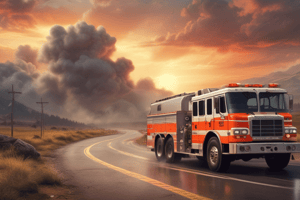Podcast
Questions and Answers
What is the primary goal of the 'Making Entry' benchmark?
What is the primary goal of the 'Making Entry' benchmark?
- To evacuate all individuals from the building
- To establish a perimeter around the fire
- To assess the situation inside the structure (correct)
- To extinguish all flames immediately
Which benchmark indicates that firefighters have begun to fight the fire directly?
Which benchmark indicates that firefighters have begun to fight the fire directly?
- Fire Under Control
- Water on Fire (correct)
- Water Supply Established
- RIT Established
What does the benchmark 'Two-Out Established' ensure?
What does the benchmark 'Two-Out Established' ensure?
- Firefighting equipment is fully operational
- The fire has been completely contained
- Two firefighters remain outside for safety (correct)
- A backup water supply is set up
Which benchmark is immediately responsible for initiating rescue operations?
Which benchmark is immediately responsible for initiating rescue operations?
What is indicated when the 'Fire Under Control' benchmark is met?
What is indicated when the 'Fire Under Control' benchmark is met?
In which situation would 'Extrication Initiated' become critical?
In which situation would 'Extrication Initiated' become critical?
What does the benchmark 'RIT Established' stand for?
What does the benchmark 'RIT Established' stand for?
What is the purpose of the 'Water Supply Established' benchmark?
What is the purpose of the 'Water Supply Established' benchmark?
Which of the following is the last benchmark to be achieved during an operation?
Which of the following is the last benchmark to be achieved during an operation?
The term 'Guidance for Managing Two-In/Two-Out' refers to what aspect of firefighting?
The term 'Guidance for Managing Two-In/Two-Out' refers to what aspect of firefighting?
Flashcards are hidden until you start studying
Study Notes
Pre Arrival
- Identify and request necessary resources to mitigate incidents effectively.
- Deliver water supply instructions before arrival if possible, especially for rural settings.
Initial Radio Reports (IRR)
- Initial radio reports should include essential information for incoming units based on Standard Operating Guidelines.
- Critical components of the report:
- Arriving unit(s) identification
- Building size categorized as small, medium, or large
- Building height identified by the number of floors
- Type of occupancy such as nursing home, auto shop, restaurant, or hotel
- Unique construction details like heavy timber, masonry, or steel
- Current smoke/fire conditions (nothing showing, light, moderate, heavy)
- Establishment of command
- Ongoing actions being taken
- Instructions for incoming units
- Use the acronym IDEAL for communication:
- I - Identify arriving unit(s)
- D - Describe observations
- E - Establish Command
- A - Specify Actions
- L - Let incoming units know specific tasks
360°
- Conduct a complete 360° assessment of the scene.
- If a full 360° is not possible, report on visible information.
- Key assessment criteria include:
- Identifying known or potential rescue areas
- Determining active and potential fire and gas flow paths
- Locating and assessing the extent of the fire
- Evaluating the size, construction, and age of the structure
- Assessing structural stability
- Identifying hazards present in the environment
Follow-up Report (FUR)
- A follow-up report should be issued after completing the 360° assessment.
Conditions Actions Needs (CAN)
- CAN report follows the 360° view and includes:
- Updates on conditions and potential hazards (such as basements or overhead wires)
- Confirmation of fire location
- Announcement of the operational mode and actions taken
- Requests for additional resources as needed
Benchmarks for Incident Response
- Important benchmarks include:
- Making entry into the structure
- Establishing water on the fire
- Confirming two-in/two-out protocol
- Ensuring water supply is established
- Declaring fire under control
- Conducting primary search operations
- Establishing Rapid Intervention Team (RIT)
- Initiating and completing extrication efforts
Guidance for Managing Two-In/Two-Out
- Management guidance for Two-In/Two-Out protocols is reserved and not detailed in the provided information.
Studying That Suits You
Use AI to generate personalized quizzes and flashcards to suit your learning preferences.




